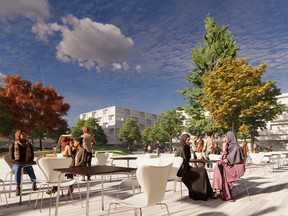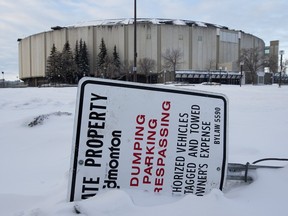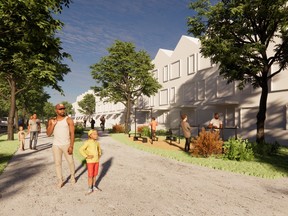[ad_1]
“It’s important for this neighbourhood to maintain its sense of history, that it’s a place of gathering.” This is Part Five of Postmedia’s How Canada Wins series.

Article content
The date was April 6, 2016. That was when the Oilers played their final game at what was then called Rexall Place, but has been known to Edmontonians through the years as Northlands Coliseum.
A 6-2 win over the Vancouver Canucks put some lipstick on another playoff-less campaign during The Decade of Darkness. Leon Draisaitl scored the final goal at the arena. After the game, players past and present gathered to celebrate almost 40 years of hockey history in the concrete arena.
Advertisement 2
Article content
“That last minute was pretty special,” said Connor McDavid of his final shift at Rexall Place. “We were all just trying to take it all in and soak it in for the last time here.”
Nine years ago feels like 900 years ago. Today, if you stand outside what used to be the home of the Edmonton Oilers, it feels empty. There is no history here. The ghosts of Gretzky, Messier, Coffey, Kurri and Fuhr have all been exorcised.
Northlands Coliseum is nothing but a husk, with grey paint covering up graffiti that had been sprayed onto grey concrete. Sitting in the middle of an unplowed, snowy parking lot, the locked-up arena looks like a flying saucer that crash landed in north Edmonton.
Across the street, scaffolding surrounds what used to be the Coliseum Inn — the city and federal government combined to spend $18.3 million to transform a hotel that was past its prime into a supportive-housing complex. The post-game parties, the exotic dancers, the late nights of celebrating yet another victory, those memories have been erased as well.
Advertisement 3
Article content
All that’s left is for this arena to be torn down, an act of mercy for a building that’s too brutal, too utilitarian to be converted into anything beautiful. The Coliseum will meet a much different fate than some of Canada’s other grand old barns. In Montreal, a movie cinema complex replaced the old Forum. In Toronto, Maple Leaf Gardens houses a supermarket and an athletic complex. If you visit, you can find the centre ice dot painted in an aisle right by the ketchup and salsa.

Edmonton’s plan
The arena and its grounds, along with the surrounding fairgrounds and abandoned race track, is prime for redevelopment. It’s more than 200 acres already connected to the city’s LRT network.
As the vision goes, the Exhibition Lands will eventually be home to 7,500 residents living in a new residential and commercial area with multi-use paths and transit accessibility. Borden Park to the south will be expanded by six acres, and Concordia University is just a bit further. North of 118 Avenue, a new transit village will see 15.5 acres of mixed use plus green space. There’s 9.5 acres reserved for commercial opportunities, and 15 acres for civic and educational facilities.
Article content
Advertisement 4
Article content
Where we see “disused fairground and arena that feel like the abandoned amusement parks from Scooby-Doo episodes,” Lovey Grewal sees opportunity. He is the project manager for the Exhibition Lands redevelopment at the City of Edmonton.
“Such great gathering spots are already there waiting for us, and we have the opportunity to build a community within it,” he said. “It’s important for this neighbourhood to maintain its sense of history, that it’s a place of gathering.”
Grewal said it will take more than two decades to finish the transformation from fairgrounds and arena to a vibrant, complete neighbourhood. The area south of the Expo Centre may be complete in 15 to 20 years. This will not be an overnight transition.
Sale of the first 20-acre parcel to a developer is pending, in the southwest corner adjacent to Borden Park, at 79 Street and 112 Avenue. Those 20 acres will be home to “ground-oriented” homes, from single-detached residences to duplexes, townhouses, row housing or apartment buildings up to six storeys. It will be up to the developers to determine what the market wants, and what is needed.
Advertisement 5
Article content
That’s a different approach to the one used for the Blatchford development to the west, where the city has acted as a hands-on developer. For that community, the city developed a vision and builders have had to buy in.
With the Exhibition Lands, the city is acting more as a facilitator, working with developers who have gone through a vetting process. A framework is in place, but the finer points are being left up to the free market.
“Let the development community construct housing and commercial properties based on their intimate knowledge of what’s needed and what’s in demand,” said Grewal. “We should be more nimble and user-focused with this approach.”
Ghosts of Blatchford
The spectre of Blatchford is real.
The old City Centre Airport lands are scheduled to be fully redeveloped by 2042, with nearly $40 million in profit for the city. But as of last year, there were less than 100 occupied homes in the community despite rapid population growth and strong housing demand in Edmonton.
Advertisement 6
Article content
In the decade that the city has had the “For Sale” sign up on Blatchford, entire south-side communities have gone from greenfield to completion.
“I have been defending this development. I think it is a beautiful development absolutely, I believe in the goals, but I am concerned about how slow we are going on this,” Mayor Amarjeet Sohi said in 2024, joining a handful of city councillors also questioning the neighbourhood’s progress.
“The development model we’re applying (for the Exhibition Lands) is different than the one with Blatchford,” said Chris Hodgson, the city’s branch manager of real estate.
“We recognize there are a number of different ways that we can work with the development community and our partners to bring forward this unique opportunity for Edmonton. I don’t think there’s necessarily a need to compare one over the other.”
Advertisement 7
Article content

Why is it important that the transformation of Exhibition Lands succeeds? Because, in the midst of a national housing crisis, every front door matters. More homes equals more supply. The better the supply, the better the chance Edmonton maintains its housing affordability advantage over other Canadian cities.
Right now, demand for new homes and population growth are having a major influence on real estate prices in the city.
A February report from the Realtors Association of Edmonton showed that the average price for a residential property was $422,000, up 11 per cent year over year. A detached home sold for an average of $553,000, up 12 per cent year over year. Those are significant increases, indicating that Edmonton’s ballyhooed affordability advantage is in a precarious position.
“It’s essential that development meets market demand in terms of timeliness of delivery, affordable price points, housing typologies offered, and neighbourhood amenities provided,” said Kalen Anderson, the CEO of BILD Edmonton Metro, which represents homebuilders and developers in the region. “Building market attainable housing quickly and efficiently is more pressing than ever as population growth surges in Edmonton.
Advertisement 8
Article content
“Leaning into our city-building successes and learning from setbacks of previous endeavours is critical.”

Timelines
Two questions are still left unanswered. When will the arena disappear? And how can Expo Centre events, festivals and K-Days coexist in a space where people may be looking for a decent night’s sleep?
As for the first question, council voted in 2022 to allocate $35 million to demolish the arena, but Sohi was against it, warning the city didn’t have the funds to do it.
This month, the province vowed to take on the costs by pledging $37.5 million toward the demolition, but it’s conditional on approval of a tripartite deal with the city and Oilers Entertainment Group to develop a $250-million event space adjacent to Rogers Place.
Hodgson said talks between the city and province are ongoing, and it’s not the time to talk specifics about the demolition plan.
Advertisement 9
Article content
“We’re still engaged in discussion on the finer details of what that will look like and feel like.”
What we do know is work has already begun on the Exhibition Lands. Barns near the old race track and the Spectrum have been torn down. Demolition of the Spectrum itself is set to begin in the summer, Grewal said. Abatement work will begin at the Coliseum site later this year. When the green light is given, it’s expected that the demolition of the former arena will take 18 months to two years.
As for K-Days, Grewal and his team will be coming back to council this coming summer with a report on how the fair can coexist with its future neighbours.
“It’s something we’re working on with external consultants, and internally as well,” he said. “We’ve been given the lead by council on this exact item in 2024. We are exploring how K-Days and how outdoor festivals and events can remain an integral part of this area, of this neighbourhood. And there’s the context of the Expo Centre as well — coexisting with what the plan calls for, which is quite a bit of new residents.”
Advertisement 10
Article content
A Washington lesson
The truth is, transforming sporting arenas that aren’t located in downtown cores is a hard thing to do. Maybe the best comparison comes from the U.S. capital region.
Prince George’s County is a Maryland suburb of Washington, D.C. Its crown jewel was once the Capital Center, later renamed the USAir Arena. It hosted concerts, NBA games and was home to the Washington Capitals when the team was most famous for losing a heck of a lot of games.
The Caps moved out in 1997, and the arena was demolished five years later with a handful of spectators cheering on the implosion. It was replaced by a shopping mall known as The Boulevard but, despite being on the Metro rapid transit line, the area didn’t need another retail haven. In 2017, it was demolished — leaving the area empty again.
A new strategy was employed to develop the area around a health care centre, which opened in 2021. There’s now a plan for a mixed-use development called Carillon, which will have residences, medical services, shopping and entertainment all in one district. But the current schedule doesn’t call for Carillon to be fully complete for almost another decade.
Advertisement 11
Article content
The Caps moved out in 1997, and in 2034, the area might finally realize a vision for what comes after.
We’ll have to see which neighbourhood wins the race — Prince George’s County or northeast Edmonton, despite the American capital region having a significant head start.
Over five weeks we are chronicling our community’s place in the country, the promise of greater prosperity, and the blueprint to get there. See the “How Canada Wins” series intro and other local stories here.
Recommended from Editorial
-

‘Ruthlessly fair’: Alberta premier says Oilers Entertainment Group deal shows fairness for Edmonton and Calgary
-

Blatchford’s latest project ‘Pilot’ breaks ground next week
Bookmark our website and support our journalism: Don’t miss the news you need to know — add EdmontonJournal.com and EdmontonSun.com to your bookmarks and sign up for our newsletters here.
You can also support our journalism by becoming a digital subscriber. Subscribers gain unlimited access to The Edmonton Journal, Edmonton Sun, National Post and 13 other Canadian news sites. Support us by subscribing today: The Edmonton Journal | The Edmonton Sun.
Article content
[ad_2]
Source link



